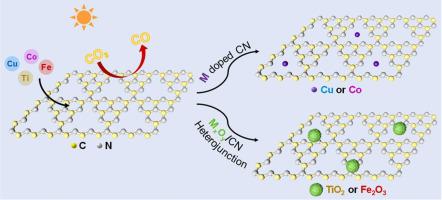Journal of CO2 Utilization ( IF 7.2 ) Pub Date : 2022-08-01 , DOI: 10.1016/j.jcou.2022.102162 Jiahui Li , Keyan Li , Jun Du , Hong Yang , Chunshan Song , Xinwen Guo

|
Incorporation of transition metals in polymeric carbon nitride (CN) is an effective strategy to enhance its photocatalytic CO2 reduction activity, however, the difference of activity enhancement by incorporating different metals is not well understood. Herein, CN is modified with different transition metals by pyrolyzing the mixtures of urea and metal-organic frameworks (MOFs) to obtain MCN (M = Cu, Co, Ti or Fe). For each given type of metal-modified CN, the photocatalytic CO2 reduction activity is optimized by controlling the content of MOF precursor during pyrolysis. The optimized MCN delivers significantly enhanced CO evolution rate than pure CN, in the order of CN (83 μmol g−1 h−1) < CuCN (246 μmol g−1 h−1) < CoCN (326 μmol g−1 h−1) < TiCN (454 μmol g−1 h−1) < FeCN (490 μmol g−1 h−1). It is revealed that for CuCN and CoCN, Cu and Co are doped in CN. In contrast, for TiCN and FeCN, Ti and Fe exist as TiO2 and Fe2O3 forming Z-scheme heterojunctions with CN. The progressively improved photocatalytic activity corresponds to the increased specific surface area, CO2 adsorption capacity, visible light absorption as well as charge separation and transfer efficiency. Furthermore, we design and prepare bimetal incorporated CN through combining metal doping with heterojunction construction strategies, i.e., Cu doped CN/TiO2 and Co doped CN/Fe2O3, which exhibit further enhanced CO2 photoreduction performance with CO evolution rates of 613 and 718 μmol g−1 h−1, respectively. This work provides insight into the design and preparation of highly efficient CN-based photocatalytic materials.
中文翻译:

过渡金属掺入对聚合氮化碳光催化CO2还原活性的影响
在聚合氮化碳(CN)中掺入过渡金属是提高其光催化CO 2还原活性的有效策略,但是,掺入不同金属对活性增强的差异尚不清楚。在此,通过热解尿素和金属有机骨架 (MOF) 的混合物,用不同的过渡金属对 CN 进行改性,得到 MCN (M = Cu、Co、Ti 或 Fe)。对于每种给定类型的金属改性CN,通过在热解过程中控制MOF前体的含量来优化光催化CO 2还原活性。优化后的 MCN 比纯 CN 提供显着提高的 CO 释放速率,顺序为 CN (83 μmol g -1 h -1 ) < CuCN (246 μmol g -1h -1 ) < CoCN ( 326 μmol g -1 h -1 ) < TiCN (454 μmol g -1 h -1 ) < FeCN (490 μmol g -1 h -1 )。揭示了对于CuCN和CoCN,Cu和Co掺杂在CN中。相反,对于 TiCN 和 FeCN,Ti 和 Fe 以 TiO 2和 Fe 2 O 3的形式存在,与 CN 形成 Z 型异质结。逐渐提高的光催化活性对应于增加的比表面积,CO 2吸附容量、可见光吸收以及电荷分离和转移效率。此外,我们通过将金属掺杂与异质结构建策略相结合,即Cu掺杂的CN/TiO 2和Co掺杂的CN/Fe 2 O 3,设计和制备了双金属掺入CN,它们表现出进一步增强的CO 2光还原性能,CO释放率为613。和718 μmol g -1 h -1,分别。这项工作为高效 CN 基光催化材料的设计和制备提供了见解。











































 京公网安备 11010802027423号
京公网安备 11010802027423号